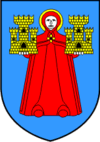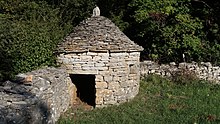Kanfanar
| Kanfanar | ||
|
||
|
|
||
| Basic data | ||
|---|---|---|
| State : |
|
|
| County : |
|
|
| Height : | 281 m. i. J. | |
| Area : | 58 km² | |
| Residents : | 1,543 (2011) | |
| Population density : | 27 inhabitants per km² | |
| Telephone code : | (+385) 052 | |
| Postal code : | 52352 | |
| License plate : | PU | |
| Structure and administration (status: 2013, cf. ) |
||
| Community type : | local community | |
| Structure : | 22 parts of the community | |
| Mayor : | Sandro Jurman ( HSLS ) | |
| Website : | ||
Kanfanar ( Italian Canfanaro ) is a municipality in the Istria County in Croatia .
geography
location
Kanfanar is located about 20 kilometers east of Rovinj , 30 kilometers north of Pula , west and east of Autocesta 9 and 281 meters above the Adriatic Sea .
Neighboring communities
The Kanfanar municipality borders in the north with the municipality Tinjan , in the east with Žminj , in the southeast with Svetvinčenat , in the south with Bale and in the west with the city of Rovinj .
structure
The municipality Kanfanar with 1,543 inhabitants consists of the 22 localities, villages and hamlets Barat , Brajkovići , Bubani , Burići , Červari , Draguzeti , Dubravci , Jural , Kanfanar, Korenići , Kurili , Ladići , Marići , Maružini , Matohanci , Mrgani , Okreti , Pilković , Putini , Sošići , Šorići and Žuntići .
climate
Kanfanar and its surrounding area are characterized by the Mediterranean climate with subtropical characteristics: the summers are bright, sunny and warm, the winters are mild.
The vegetation is typically Mediterranean and consists mainly of forest communities with oriental hornbeams and downy oaks .
history
The first traces of settlement date from the Bronze and Iron Ages : Corresponding finds were secured in a tumulus ( barrow ) near Šorići and in the cave near Kašteljir.
The current city of Kanfanar emerged from the two smaller villages Parentino and Moncastello . Parention has Illyrian roots but was later abandoned. Moncastello, later called Duecastello (today Dvigrad ), lost its inhabitants in 1631 due to epidemic diseases and today's Kanfanar emerged as their new settlement. The current ruins of Dvigrad were used as building material.
Economy and Infrastructure
economy
The city's economic base consists mainly of small businesses and tourist activities. On the western edge of the city there is a large limestone quarry, which supplies a light beige rock from the chalk formation for construction and decoration purposes. This stone with the same name as his city is known nationwide. There is a large tobacco processing factory on the outskirts of the village.
traffic
Kanfanar has a motorway link to the north-south direction leading Istrian highway A9 and an interface for from Rovinj to Matulji in Rijeka leading Autocesta A8 .
State roads 75 and 303 , district roads 5076, 5077 and 5097 as well as district roads 50101, 50102, 50128 and 50131 run through the municipality .
The municipality has a train station on the Divača – Pula railway line . A connection to the narrow-gauge local railway Trieste – Parenzo (“Parenzobahn”), which began in 1900, was omitted because the third planned section, Poreč – Kanfanar, was never built.
Culture and sights
Culture
In the municipality of Kanfanars there are several Kažuni made of dry stone , up to 30 m² in size, round stone buildings with a ceiling made of a cantilever vault . They served as shelter in fields and vineyards.
Attractions
Ruined city of Dvigrad
Dvigrad is a ruined city in the Draga Valley, built on the remains of a prehistoric settlement and abandoned since 1631 .
Sacred buildings
- Basilica of Saint Sophie
The Basilica of St. Sophie was built in the 5th or 6th century on the highest plateau in Dvigrad . The three-aisled basilica with three apses was given its current appearance in the Romanesque era ( 13th century ).
- Marienkirche Madonna am See
Within a small cemetery below the ruined city of Dvigrad is in the 14th century built Gothic St. Mary's Church Madonna am See . In the presbytery of the four-sided stone building, frescos by the “ Colorful Master ” can be admired.
- St. Agatha
On the road to Vidulini is the church of St. Agatha , the oldest church in the municipality. It is believed that it was built at the end of the 10th century . The nave with slate -covered stone building with a square outer apse is inside with frescoes , from which are under strong Byzantine influence 11th century decorated.
- St. New Years Eve
The church of St. Silvester in Kanfanar, built from 1695 on the foundation of a smaller church, has three altars . The main altar is dedicated to St. New Year's Eve and St. Sophia , the smallest altar bears the name of St. Anthony of Padua . The pulpit once belonged to the furniture of the basilica in Dvigrad . The 25 meter high bell tower was built in 1732 and has three bells.
In St. New Year's Eve , the surviving liturgical objects from the church of Dvigrad and a copy of one of the most important relics of Christianity - the Turin shroud - are kept.
sons and daughters of the town
- Giovanni Glavinìch / Franjo Glavinić (born June 23, 1585, † December 6, 1652 in Trsat / Tersatto), Franciscan, theologian, man of letters, historian
- Gregorio Franisovich († 1810 in Capodistria), officer and participant in the Turkish wars in the Balkans
literature
- Tourist Community of Kanfanar Municipality (Ed.): Kanfanar Tourist Guide . 2018.
- Hans-Dieter Kaspar, Elke Kaspar, Anton Meden: Kanfanar in prehistoric times . Norderstedt 2010, ISBN 978-3-8391-6689-5 .
Web links
- Community side (Croatian)
- Website of the parish of Sv. Silvestar (Croatian)
- Canfanaro - Kanfanar (Italian)
- Biography of Franjo Glavinić (English)
Individual evidence
- ↑ 2011 census





